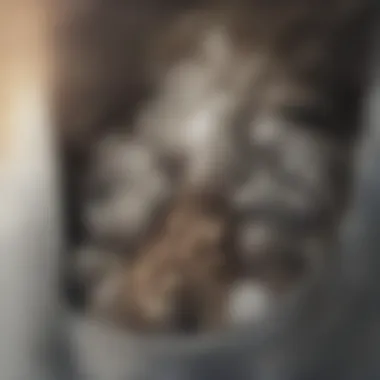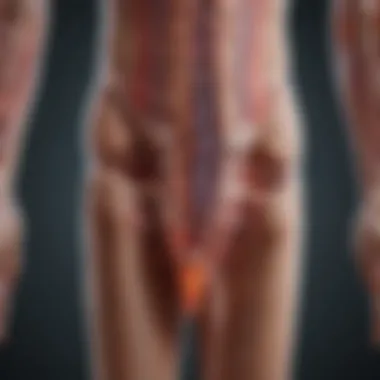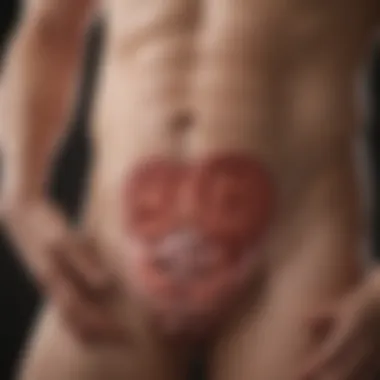Exploring the Link Between Diverticulitis and Leg Pain


Intro
Diverticulitis is often misunderstood and simplified in discussions surrounding digestive health. That said, many individuals do not recognize the wider health implications it may have beyond the abdomen. This article aims to clarify the complex interaction between diverticulitis and leg pain, drawing attention to how an inflammation of the colon can sometimes manifest as discomfort in the lower extremities.
Article Overview
Summary of Key Findings
- Connection Between Diverticulitis and Leg Pain: The connection may stem from referred pain, where pain sensations are perceived in areas different from the origin.
- Symptoms: While common symptoms of diverticulitis include abdominal pain, nausea, and changes in bowel habits, some patients report leg pain. This may occur due to nerve pathways being influenced by irritation around the abdomen.
- Diagnosis and Management: Understanding the underlying mechanisms can aid in accurate diagnosis. Treatment often requires a multidisciplinary approach, addressing both gastrointestinal and musculoskeletal aspects.
Research Objectives
The goal of this article is to:
- Explore the mechanisms that link diverticulitis to leg pain.
- Examine the symptoms and complications related to both conditions.
- Present diagnostic methods and treatment strategies to manage these interconnected health issues effectively.
Key Results and Discussions
Main Findings
Research indicates that individuals with diverticulitis may experience leg pain due to referred pain from the inflamed colon. Through a study of pain intensity and location, it appears that the body can misattribute pain signals, causing discomfort in the legs.
It's important to note that while leg pain can feel unrelated, the central nervous system plays a crucial role in how pain is perceived.
Implications of Findings
These findings suggest that healthcare providers should consider a patient’s complete symptom profile when diagnosing and treating conditions. Ignoring leg pain in the presence of diverticulitis could lead to inadequate treatment plans, prolonging patient discomfort and complicating recovery.
Intro to Diverticulitis
Diverticulitis is a condition that has gained attention in recent years due to its increasing prevalence and the complications that can arise from it. Understanding this disease is critical, not just for healthcare professionals, but also for patients and their families. In this article, we will discuss diverticulitis in detail to highlight how it might relate to leg pain.
Definition and Overview
Diverticulitis arises when small pouches, called diverticula, form in the wall of the colon and become inflamed or infected. This can lead to severe abdominal pain, fever, and changes in bowel habits. The exact cause of diverticulitis is unknown, but factors such as a low-fiber diet, lack of exercise, and aging may contribute to its development. A firm grasp on what diverticulitis is helps in understanding its potential connections to other symptoms, including leg pain.
Epidemiology
The epidemiology of diverticulitis indicates that this condition is more frequent in Western populations. Studies show that about 10-25% of individuals with diverticulosis— the precursor to diverticulitis— will experience an episode of diverticulitis during their lifetime. Additionally, the incidence of diverticulitis is higher in individuals over 40 years, especially in those with a sedentary lifestyle. Recognizing the trends in diverticulitis assists both medical practitioners and patients in being vigilant and informed.
Pathophysiology of Diverticulitis
Understanding the pathophysiology of diverticulitis is crucial for appreciating why some patients might experience leg pain associated with the condition. When diverticula become inflamed, they can affect surrounding tissues, leading to complications like abscesses and perforation. This inflammation may cause adjacent structures to react, potentially leading to referred pain, where discomfort is felt in other parts of the body, such as the legs. The body’s intricate pain signaling mechanisms can sometimes make it challenging to pinpoint the exact source of discomfort, necessitating a thorough examination to unravel these complexities.
Understanding Leg Pain
Leg pain is a common issue that affects many people at different stages in life. This section serves to highlight the significance of understanding leg pain, particularly in the context of its potential connection to diverticulitis. Recognizing the nuances of leg pain can inform better diagnosis and treatment strategies, especially when such pain may arise from less obvious sources like digestive issues. Given that leg pain can stem from an array of causes, including muscular, skeletal, and neurological factors, a clear grasp on this topic is essential. This encourages a holistic approach to patient care where interdisciplinary insights can lead to improved health outcomes.
Types of Leg Pain
Acute vs. Chronic Pain


Acute leg pain is characterized by a sudden onset, often resulting from injury or trauma. It tends to be severe but usually improves over time with proper care. This immediacy and intensity generally make acute pain a noteworthy topic in medical discussions. In contrast, chronic leg pain lingers for an extended period, often making it a challenge to diagnose and treat effectively. The distinction between acute and chronic pain is beneficial for identifying underlying causes, which is vital for establishing a treatment plan. Focusing specifically on either type allows for targeted therapeutic interventions.
Muscle vs. Nerve Pain
Muscle pain, or myalgia, usually involves soreness or discomfort in specific muscles, frequently resulting from overuse, strain, or injury. Nerve pain, known as neuropathic pain, differs as it often presents as sharp, burning sensations or tingling. Understanding muscle versus nerve pain is crucial in accurately diagnosing conditions. For patients with diverticulitis, distinguishing between these two types can reveal if leg pain is a byproduct of inflammation or other factors internal to the body. Each pain type has unique characteristics making them significant in clinical assessments and treatment plans.
Common Causes of Leg Pain
Leg pain can arise from various factors. Some common causes include:
- Muscular injuries: Strains and sprains are frequent culprits.
- Arthritis: Joint inflammation can radiate discomfort to the leg.
- Vascular issues: Problems with blood circulation can lead to leg pain.
- Nerve conditions: Sciatica and other nerve disorders can manifest as leg pain.
- Infections: Certain infections may also lead to discomfort.
Recognizing these causes is vital for proper management and understanding the relationship between conditions like diverticulitis and leg pain.
Symptoms Associated with Leg Pain
Numbness and Tingling
Numbness and tingling in the legs can indicate nerve involvement. This symptom is characterized by a loss of sensation or a prickling feeling. It is noteworthy as it informs healthcare providers about potential underlying neuropathic issues. Understanding this symptom helps distinguish whether leg pain is a result of diverticulitis or other causes. The precise nature of numbness can significantly influence treatment approaches and patient management.
Swelling and Inflammation
Swelling and inflammation often accompany pain in the legs. This condition can result from various underlying mechanisms, such as injury or vascular problems. In cases of diverticulitis, inflammation in the abdominal area could theoretically lead to referred pain and subsequent swelling in the extremities. This connection emphasizes the importance of considering gastrointestinal disorders when evaluating leg pain, thus enhancing clinical understanding and patient care.
Can Diverticulitis Cause Leg Pain?
Diverticulitis is often discussed in relation to gastrointestinal symptoms and complications. However, the connection to leg pain is less clear and not frequently addressed in medical literature. Understanding whether diverticulitis can cause leg pain is significant for both diagnostics and treatment planning. This exploration may uncover underlying mechanisms that contribute to such discomfort, fostering better management of symptoms and improving patient outcomes.
Theoretical Connections
Referred Pain Mechanism
Referred pain is a phenomenon where pain is perceived at a location different from its source. In the context of diverticulitis, this means that irritation or inflammation in the colon could manifest as pain in the legs. The key characteristic of this mechanism is that the body’s pain pathways can misinterpret the origin of pain signals.
This is particularly relevant because it allows clinicians to consider gastrointestinal issues when evaluating leg pain. It is a beneficial choice in this article, as it broadens the perspective on how diverticular conditions may present. A unique feature of this mechanism is its emphasis on the neurological pathways involved, which can illuminate the complexity of pain perception.
The advantage of understanding referred pain is that it can lead to a more comprehensive approach to patient assessment, potentially preventing misdiagnosis. Conversely, a disadvantage may lie in the need for thorough evaluation to rule out other causes of leg pain, which can complicate the diagnostic process.
Inflammation and Its Effects
Inflammation is a crucial factor in many medical conditions, including diverticulitis. Its impact on the body can extend beyond gastrointestinal discomfort. Inflammation can lead to increased sensitivity in surrounding tissues and muscles, potentially causing pain in adjacent areas, including the legs.
The key characteristic of inflammation in this context is its ability to initiate pain pathways. The article benefits from this discussion as it provides insight into how systemic inflammation might contribute to non-localized pain. A unique feature of this aspect is the potential for chronic inflammation to prompt ongoing discomfort, even after initial diverticulitis symptoms have resolved.
Recognizing the advantages of understanding inflammation’s role is critical for developing effective treatment modalities. However, a disadvantage might be the overlapping symptoms with other inflammatory conditions affecting the legs, necessitating careful differentiation for proper diagnosis.
Clinical Case Studies
Examining clinical case studies where patients presented with both diverticulitis and leg pain can provide valuable insights. They highlight the variance in symptoms and underline the necessity for thorough patient history. This section will explore such instances where both conditions coexisted, offering real-world context to theoretical discussions surrounding referred pain and inflammation.
Differential Diagnosis
Excluding Other Conditions


When addressing leg pain in a patient with diverticulitis, it is crucial to exclude other potential causes. Conditions such as sciatica, deep vein thrombosis, and peripheral artery disease may also present with leg pain. The key characteristic of this aspect is the necessity of a comprehensive diagnostic strategy.
By incorporating this into the discussion, the article emphasizes the importance of ruling out conditions that may mimic or accompany leg pain in diverticulitis sufferers. A unique feature of this approach is that it encourages detailed examinations and possibly imaging studies to confirm or deny other diagnoses.
Advantages of excluding other conditions lie in avoiding inappropriate treatments. However, a disadvantage is that the diagnostic process may become lengthy, potentially delaying effective management of symptoms.
Specificity of Symptoms
The specificity of symptoms can provide valuable clues in diagnosing diverticulitis-related leg pain. Understanding the distinct characteristics of leg pain occurring alongside diverticulitis can aid in establishing appropriate management plans. Key characteristics include the nature of the pain, its onset, and associated gastrointestinal symptoms.
This specificity is a beneficial choice for the article as it highlights the critical nature of accurate symptom assessment. The unique feature here is that it assists healthcare providers in linking symptoms more effectively, leading to better treatment outcomes.
The advantages of emphasizing symptom specificity allow for tailored treatments, whereas the disadvantages might involve challenges in patient description or reporting of symptoms, which can lead to misinterpretations.
Diagnosis of Diverticulitis-Related Leg Pain
Diagnosing leg pain associated with diverticulitis is an essential process that integrates a multidisciplinary approach. Identifying the source of pain is critical because the symptoms may overlap with other conditions, thus complicating accurate diagnosis. The diagnosis needs careful consideration of patient history, physical examination, and imaging techniques. This complexity highlights the need for precise diagnostic methods to ensure effective management and treatment.
Diagnostic Imaging Techniques
CT Scans
CT scans are a significant tool in diagnosing diverticulitis-related leg pain. This imaging method provides detailed cross-sectional images of the abdomen, allowing clinicians to see the inflamed diverticula and assess the extent of the disease. One key characteristic of CT scans is their ability to quickly indicate complications such as abscesses or perforations.
CT scans are beneficial due to their speed and accuracy. They can help identify diverticular disease even in patients who may not show typical symptoms.
However, one unique feature of CT scans is the exposure to ionizing radiation. While the risk is generally low, it is a consideration for certain populations, especially younger patients. In summary, CT scans stand out as a preferred method in the diagnostic portfolio due to their efficacy and comprehensiveness, despite their limitations.
Ultrasound
Ultrasound serves as another valuable diagnostic tool in assessing diverticulitis and potentially related leg pain. This imaging method uses sound waves to create images of the organs in the abdomen. One key characteristic of ultrasound is that it does not involve radiation, making it safer for repeated usage.
Ultrasound is particularly advantageous in evaluating superficial inflamed areas and differentiating them from deeper structures involved in diverticulitis. A unique feature of ultrasound is its real-time imaging ability, allowing for dynamic assessment of the affected areas.
However, its limitations include operator dependency and difficulty visualizing deep structures. Nonetheless, ultrasound remains a useful tool in the early assessment and can complement findings from CT scans.
Clinical Assessment
Patient History
Patient history is a foundational aspect of diagnosing diverticulitis-related leg pain. Detailed accounts of the symptoms, duration, and previous medical history can provide crucial insights. One key characteristic of this method is its non-invasive nature, allowing for initial assessment without any imaging.
Gathering a thorough history is beneficial as it aids in guiding further diagnostic efforts. It can help exclude conditions that may present similarly to diverticulitis. A unique feature of patient history is that it can uncover risk factors or patterns that point toward complications. However, its reliance on accurate patient reporting can be a disadvantage, as it may not always be reliable.
Physical Examination
Physical examination complements patient history in the diagnostic process. This examination involves assessing the abdomen for signs of tenderness or swelling and checking for warmth in the legs. A crucial characteristic of a physical examination is its ability to provide immediate feedback on a patient's condition.
This method is beneficial because it can often reveal acute inflammation or other conditions that may need attention. Unique to physical examination is the ability to gather real-time data through palpation and observation. However, this assessment is limited by its subjectivity and may miss deeper issues requiring imaging confirmation.
Management of Pain Related to Diverticulitis
Managing pain related to diverticulitis is crucial for improving the quality of life for affected individuals. Pain can vary significantly in intensity and nature, making personalized treatment strategies essential. A comprehensive approach can not only relieve discomfort but also enhance recovery and prevent further complications. This segment will delve into various management strategies including medical treatment, surgical options, and lifestyle modifications.


Medical Treatment Options
Antibiotics
Antibiotics are a core component in the management of diverticulitis-related pain. They help combat bacterial infection, which can exacerbate the inflammatory condition. The key characteristic of antibiotics is their effectiveness in reducing infection. This makes them a popular choice in treating diverticulitis. Amoxicillin-clavulanate and Metronidazole are commonly prescribed antibiotics for diverticulitis. Each has individual strengths, but their role primarily lies in curbing inflammation through infection control.
However, the use of antibiotics may have disadvantages. Over-reliance can lead to antibiotic resistance, complicating future treatment options. It’s crucial to balance their use with other methods.
Pain Management
Pain management is an essential strategy for individuals suffering from diverticulitis. The primary aim is to alleviate discomfort and improve patient comfort. Non-steroidal anti-inflammatory drugs, such as ibuprofen, are typically recommended due to their effectiveness in pain relief. Furthermore, they help reduce inflammation, providing dual benefits.
One unique feature of pain management is its flexibility. Pain relief can be adjusted based on individual needs and responses to medication. However, patients must be cautious regarding long-term use, as it can lead to gastrointestinal complications. Thus, regular consultation with healthcare providers is key to ensure safety and efficacy.
Surgical Intervention
Indications for Surgery
Surgical intervention may become necessary for patients who do not respond to conservative treatments or experience recurrent episodes of diverticulitis. The primary reason for surgery, often an elective procedure, is to remove the affected portion of the colon. The indication for surgery illustrates the severity of the condition and the failure of medical management.
Surgery is beneficial in preventing future diverticulitis attacks and complications like abscess formation or bowel obstruction. However, surgery carries risks, including infection and complications from anesthesia. Therefore, a comprehensive evaluation is crucial before proceeding.
Postoperative Considerations
Postoperative considerations play a vital role in recovery following surgical intervention for diverticulitis. Patients must be educated on postoperative care to facilitate healing and avoid complications. Wound care, pain management, and gradually reintroducing diet are important aspects of recovery.
A unique feature of postoperative management is the need for follow-up care. This includes monitoring for infection, assessing recovery progress, and adjusting medications as required. While surgery can significantly improve symptoms, adherence to postoperative protocols is essential for a successful outcome.
Lifestyle and Dietary Adjustments
Fiber-Rich Diet
Incorporating a fiber-rich diet is paramount in managing diverticulitis. Fiber can help in maintaining regular bowel movements and reduce the pressure within the colon. By doing so, it addresses one of the underlying factors contributing to diverticulitis flare-ups.
A key characteristic is that a high-fiber diet promotes overall gut health by preventing constipation. Foods such as fruits, vegetables, and whole grains should be prioritized. Nevertheless, during acute episodes of diverticulitis, a low-fiber diet may be preferred to reduce bowel movement and inflammation temporarily. Thus, adjusting dietary intake is imperative based on individual symptoms.
Hydration
Staying well-hydrated is another critical adjustment for individuals managing pain related to diverticulitis. Proper hydration aids in digestion and prevents constipation, complicating diverticulitis symptoms. The value of hydration extends beyond bowel regulation; it supports overall bodily functions.
A unique aspect of maintaining hydration is setting achievable goals, such as aiming for eight glasses of water daily. Yet, the approach should be personalized. Some individuals may need to adjust fluid intake based on their activity level or underlying health issues. Keeping a balance is crucial in promoting recovery and managing pain.
Finale
In this article, we examined the complex relationship between diverticulitis and leg pain. Understanding this connection is fundamental for both healthcare professionals and patients. By recognizing the nuances of diverticulitis, practitioners can provide more effective diagnoses and treatments, ultimately improving patient outcomes. Moreover, addressing leg pain in the context of diverticulitis opens new avenues for symptom management that may enhance the overall health and quality of life for individuals experiencing both conditions.
Summarizing Key Findings
The exploration of diverticulitis and its potential link to leg pain reveals several key findings:
- Diverticulitis primarily involves inflammation in the colon, yet its consequences might extend beyond gastrointestinal symptoms.
- Referred pain is a significant phenomenon that could explain leg discomfort in patients diagnosed with diverticulitis.
- The evidence from clinical studies suggests a subset of patients indeed experiences leg pain corresponding with diverticular flare-ups, making it a relevant area for clinical consideration.
- Diagnostic imaging, such as CT scans and ultrasound, plays a crucial role in both identifying diverticulitis and evaluating accompanying leg pain.
These findings collectively highlight the necessity to consider a broader range of symptoms and their possible interconnections.
Implications for Future Research
The implications for future research in this arena are notable. Understanding the relationship between diverticulitis and leg pain warrants further exploration on several fronts:
- Mechanistic Studies: Investigating the pathophysiological mechanisms would elucidate how abdominal inflammation might lead to referred pain in the legs.
- Longitudinal Research: Tracking a cohort of patients with diverticulitis over time could reveal patterns of leg pain occurrence and identify potential triggers.
- Interventional Trials: Studying various treatment modalities that address both diverticulitis management and leg pain could offer evidence-based options for better care.
- Patient Education: Research focused on educating patients about the potential for leg pain related to diverticulitis can improve self-advocacy and symptom awareness.







